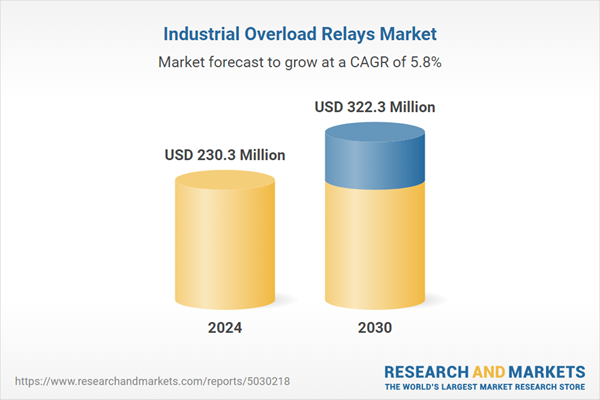Global Industrial Overload Relays Market - Key Trends & Drivers Summarized
Why Are Industrial Overload Relays Essential for Electrical Safety and Equipment Protection?
Industrial overload relays play a critical role in protecting electrical motors and other heavy-duty industrial equipment from excessive current and overheating. These devices serve as a crucial component in motor control systems, preventing electrical failures, reducing downtime, and extending the lifespan of machinery in manufacturing plants, oil and gas facilities, power stations, and other high-power applications. Overload relays function by sensing excessive current flow and triggering a shutdown mechanism before any damage occurs, thereby preventing costly repairs and replacements. There are two primary types of overload relays - thermal and electronic - each catering to different operational needs. Thermal overload relays rely on a bi-metallic strip to detect excessive heat, while electronic overload relays use advanced sensors and microprocessors to provide real-time monitoring and adjustable protection. With the increasing complexity of industrial automation and motor-driven applications, the demand for overload relays with higher accuracy, faster response times, and integrated communication capabilities has surged. Additionally, industries are moving towards smart overload relay solutions that offer remote monitoring and predictive maintenance functionalities, enabling better control over motor performance and reducing the risk of unplanned shutdowns. The need for reliable motor protection has never been higher, as industrial operations continue to grow in scale, complexity, and energy intensity.How Are Technological Advancements Revolutionizing Industrial Overload Relays?
The industrial overload relays market has been significantly transformed by technological advancements, leading to the development of smarter, more efficient, and highly responsive protection solutions. The integration of digital sensors, microcontrollers, and IoT-enabled functionalities has enabled real-time data collection and remote monitoring, allowing plant operators to detect anomalies before they escalate into major issues. Modern electronic overload relays now come equipped with adjustable trip settings, precise load monitoring, and automatic reset capabilities, making them far superior to traditional thermal relays in terms of accuracy and adaptability. Additionally, the rise of Industry 4.0 has accelerated the adoption of overload relays with built-in communication interfaces, such as Modbus, Ethernet/IP, and PROFIBUS, enabling seamless integration into factory automation and SCADA (Supervisory Control and Data Acquisition) systems. Another major innovation in the market is the development of solid-state overload relays, which offer enhanced reliability, minimal wear and tear, and improved temperature tolerance compared to electromechanical variants. Furthermore, manufacturers are focusing on improving relay designs with self-diagnostic capabilities that can predict failures, alert operators, and trigger corrective actions without manual intervention. The growing emphasis on energy efficiency has also led to the introduction of overload relays that optimize power consumption by dynamically adjusting motor loads, reducing energy waste and operational costs. As industries continue to push for smarter and safer electrical systems, the demand for intelligent, networked overload relay solutions is set to rise, shaping the future of motor protection technologies.Why Is the Demand for Industrial Overload Relays Growing Across Multiple Sectors?
The widespread adoption of industrial overload relays across various sectors is driven by the increasing reliance on electric motors in critical industrial applications. The manufacturing industry remains one of the largest consumers, as motors are extensively used in automated production lines, conveyor systems, and material handling equipment, all of which require reliable overload protection to avoid operational disruptions. The energy sector, particularly in renewable energy projects such as wind and solar farms, also relies heavily on overload relays to safeguard transformers, inverters, and grid-connected electrical systems from current surges. In the oil and gas industry, where extreme operating conditions and hazardous environments pose additional risks, overload relays are essential for protecting drilling equipment, compressors, and pumps from electrical overloads and short circuits. The water and wastewater treatment sector is another significant end-user, utilizing overload relays in pump stations and filtration systems to maintain continuous operations and prevent damage to critical infrastructure. Additionally, the mining industry, where heavy-duty machinery operates under high stress, is increasingly adopting advanced overload protection solutions to ensure the longevity and reliability of critical equipment such as crushers, grinders, and ventilation systems. The demand is also rising in commercial infrastructure projects, where overload relays are deployed in HVAC systems, elevators, and automated building controls to enhance safety and energy efficiency. As industries continue to adopt more sophisticated electrical systems and automated processes, the need for reliable overload protection solutions is expected to grow exponentially.What Are the Key Factors Driving the Growth of the Industrial Overload Relays Market?
The growth in the industrial overload relays market is driven by several factors, including advancements in motor protection technology, increasing automation in industrial processes, and the rising demand for energy-efficient solutions. The transition toward smart factories and Industry 4.0 has significantly boosted demand for IoT-enabled overload relays, which allow real-time monitoring, remote diagnostics, and predictive maintenance, reducing downtime and operational risks. The rapid expansion of renewable energy infrastructure has also played a crucial role in driving market growth, as overload relays are essential for protecting wind turbines, solar inverters, and battery storage systems from electrical faults. Additionally, the rising global focus on workplace safety and regulatory compliance has compelled industries to invest in advanced overload protection solutions that meet international standards for electrical safety. Another critical factor is the increasing electrification of industries, where electric motors are replacing traditional mechanical systems, further emphasizing the need for high-performance overload relays. The growing demand for cost-effective and modular relay solutions has led manufacturers to develop more compact, user-friendly designs that offer easy installation and maintenance. Moreover, as industrial equipment becomes more interconnected, the adoption of overload relays with integrated communication protocols is becoming a key trend, enabling seamless control and coordination within industrial networks. With continuous innovations in sensor technology, circuit protection, and automation, the industrial overload relays market is poised for significant growth, driven by the increasing complexity and electrification of industrial operations worldwide.Report Scope
The report analyzes the Industrial Overload Relays market, presented in terms of units. The analysis covers the key segments and geographic regions outlined below.Segments: Product (Thermal, Magnetic); Application (Motors, Generators).
Geographic Regions/Countries: World; United States; Canada; Japan; China; Europe (France; Germany; Italy; United Kingdom; Spain; Russia; and Rest of Europe); Asia-Pacific (Australia; India; South Korea; and Rest of Asia-Pacific); Latin America (Argentina; Brazil; Mexico; and Rest of Latin America); Middle East (Iran; Israel; Saudi Arabia; United Arab Emirates; and Rest of Middle East); and Africa.
Key Insights:
- Market Growth: Understand the significant growth trajectory of the Thermal Overload Relays segment, which is expected to reach US$232.3 Million by 2030 with a CAGR of a 5.6%. The Magnetic Overload Relays segment is also set to grow at 6.2% CAGR over the analysis period.
- Regional Analysis: Gain insights into the U.S. market, valued at $60.2 Million in 2024, and China, forecasted to grow at an impressive 8.6% CAGR to reach $73.2 Million by 2030. Discover growth trends in other key regions, including Japan, Canada, Germany, and the Asia-Pacific.
Why You Should Buy This Report:
- Detailed Market Analysis: Access a thorough analysis of the Global Industrial Overload Relays Market, covering all major geographic regions and market segments.
- Competitive Insights: Get an overview of the competitive landscape, including the market presence of major players across different geographies.
- Future Trends and Drivers: Understand the key trends and drivers shaping the future of the Global Industrial Overload Relays Market.
- Actionable Insights: Benefit from actionable insights that can help you identify new revenue opportunities and make strategic business decisions.
Key Questions Answered:
- How is the Global Industrial Overload Relays Market expected to evolve by 2030?
- What are the main drivers and restraints affecting the market?
- Which market segments will grow the most over the forecast period?
- How will market shares for different regions and segments change by 2030?
- Who are the leading players in the market, and what are their prospects?
Report Features:
- Comprehensive Market Data: Independent analysis of annual sales and market forecasts in US$ Million from 2024 to 2030.
- In-Depth Regional Analysis: Detailed insights into key markets, including the U.S., China, Japan, Canada, Europe, Asia-Pacific, Latin America, Middle East, and Africa.
- Company Profiles: Coverage of players such as ABB Group, Benshaw Inc., Coto Technology USA, Danfoss A/S, Eaton Corporation PLC and more.
- Complimentary Updates: Receive free report updates for one year to keep you informed of the latest market developments.
Some of the 38 companies featured in this Industrial Overload Relays market report include:
- ABB Group
- Benshaw Inc.
- Coto Technology USA
- Danfoss A/S
- Eaton Corporation PLC
- Emera Inc.
- Finder S.p.A.
- Fuji Electric Co., Ltd.
- General Electric Company
- Global Zeus
- GREEGOO Electric Co., Ltd.
- GWIEC Electric
- Hubbell Industrial Controls, Inc.
- Kawamura Electric, Inc.
- Littelfuse, Inc.
- Lovato Electric SpA
- Meba Electric Co., Ltd.
- Mitsubishi Electric Corporation
- MTE Corporation
- Riken Electric Co., Ltd.
- Rockwell Automation, Inc.
- Schneider Electric SA
- Siemens AG
- Sprecher+Schuh
- Struthers-Dunn, LLC
- Texas Instruments, Inc.
- Tsubakimoto Chain Co. (Tsubaki Group)
- WEG Equipamentos Eletricos S.A.
Tariff Impact Analysis: Key Insights for 2025
Global tariff negotiations across 180+ countries are reshaping supply chains, costs, and competitiveness. This report reflects the latest developments as of April 2025 and incorporates forward-looking insights into the market outlook.The analysts continuously track trade developments worldwide, drawing insights from leading global economists and over 200 industry and policy institutions, including think tanks, trade organizations, and national economic advisory bodies. This intelligence is integrated into forecasting models to provide timely, data-driven analysis of emerging risks and opportunities.
What’s Included in This Edition:
- Tariff-adjusted market forecasts by region and segment
- Analysis of cost and supply chain implications by sourcing and trade exposure
- Strategic insights into geographic shifts
Buyers receive a free July 2025 update with:
- Finalized tariff impacts and new trade agreement effects
- Updated projections reflecting global sourcing and cost shifts
- Expanded country-specific coverage across the industry
Table of Contents
Companies Mentioned (Partial List)
A selection of companies mentioned in this report includes, but is not limited to:
- ABB Group
- Benshaw Inc.
- Coto Technology USA
- Danfoss A/S
- Eaton Corporation PLC
- Emera Inc.
- Finder S.p.A.
- Fuji Electric Co., Ltd.
- General Electric Company
- Global Zeus
- GREEGOO Electric Co., Ltd.
- GWIEC Electric
- Hubbell Industrial Controls, Inc.
- Kawamura Electric, Inc.
- Littelfuse, Inc.
- Lovato Electric SpA
- Meba Electric Co., Ltd.
- Mitsubishi Electric Corporation
- MTE Corporation
- Riken Electric Co., Ltd.
- Rockwell Automation, Inc.
- Schneider Electric SA
- Siemens AG
- Sprecher+Schuh
- Struthers-Dunn, LLC
- Texas Instruments, Inc.
- Tsubakimoto Chain Co. (Tsubaki Group)
- WEG Equipamentos Eletricos S.A.
Table Information
| Report Attribute | Details |
|---|---|
| No. of Pages | 242 |
| Published | April 2025 |
| Forecast Period | 2024 - 2030 |
| Estimated Market Value ( USD | $ 230.3 Million |
| Forecasted Market Value ( USD | $ 322.3 Million |
| Compound Annual Growth Rate | 5.8% |
| Regions Covered | Global |









